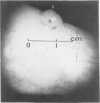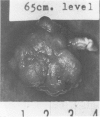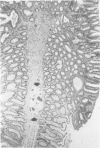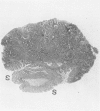Abstract
There has been an unremitting rise in incidence of colonic cancer in this country with no recent improvement in cure rate. As a result the evolution of colorectal cancer has been the focus of considerable attention with an enlarging body of evidence pointing to the common neoplastic polyp as a precursor to malignancy. "Neoplastic" polyps include "adenomatous polyps," "villous adenomas" and, lately recognized, "villo-glandular polyps." Experience with endoscopic removal of over 2,000 colonic polyps (with no mortality) has introduced two questions of prime concern to the surgeon: (1) What constitutes clinical malignancy in a polyp? AND, (2) When should laparatomy supplant or follow endoscopic removal? Eight hundred and ninety-two consecutive adenomatous (tubular), villous, villoglandular (villo-tubular) and "polypoid cancer" polyps are analyzed, 855 of which have been followed for 6 months to 4 years. Support is offered to the concept that villous and tubular growth patterns are merely variants of a similar base disturbance in cell renewal. Superficial cancer (carcinoma-in-situ) occurred in 6.6% of neoplastic polyps and represents no threat if the polyp is completely removed. Only when the cancer penetrates the muscularis mucosae should it be regarded as "invasive." The term "malignant polyp" should be reserved for this form. Invasive cancer was found in 5.0% of neoplastic polyps in this series. Only in this group need the question of further surgical intervention be raised. Major considerations influencing a decision for subsequent laparotomy are polyp size and gross morphology (i.e. sessile or pedunculated), histologic type (of the polyp and of the cancer itself), adequacy of clearance between depth of invasion and plane of polyp resection, and the patient's age and general condition. These are analyzed. Twenty-five of 46 patients with "malignant polyps" were subjected to abdominal exploration: 17 showed no residual cancer, whereas 8 (5 with recognized incomplete endoscopic removal) had tumor in the bowel wall. Of the remaining 21 patients, for whom endoscopic polypectomy alone was deemed appropriate, none have shown residual or recurrent cancer on clinical and endoscopic followup. Colonoscopy appears to be a most promising approach in terms of the goals of cancer programs, offering both prophylaxis and opportunity for treatment at a favorable stage of disease.
Full text
PDF









Images in this article
Selected References
These references are in PubMed. This may not be the complete list of references from this article.
- CASTLEMAN B., KRICKSTEIN H. I. Do adenomatous polyps of the colon become malignant? N Engl J Med. 1962 Sep 6;267:469–475. doi: 10.1056/NEJM196209062671001. [DOI] [PubMed] [Google Scholar]
- CASTLEMAN B., KRICKSTEIN H. I. Polyps of the colon. Surg Gynecol Obstet. 1963 Jun;116:752–753. [PubMed] [Google Scholar]
- ENTERLINE H. T., EVANS G. W., MERCUDO-LUGO R., MILLER L., FITTS W. T., Jr Malignant potential of adenomas of colon and rectum. JAMA. 1962 Feb 3;179:322–330. doi: 10.1001/jama.1962.03050050012003. [DOI] [PubMed] [Google Scholar]
- FIGIEL L. S., FIGIEL S. J., WIETERSEN F. K. Is surgical removal of every colonic polyp necessary? Am J Roentgenol Radium Ther Nucl Med. 1962 Oct;88:721–732. [PubMed] [Google Scholar]
- FISHER E. R., CASTRO A. F. Diffuse papillomatous polyps (villous tumors) of the colon and rectum; pathologic and clinical observations. Am J Surg. 1953 Feb;85(2):146–151. doi: 10.1016/0002-9610(53)90474-7. [DOI] [PubMed] [Google Scholar]
- GOLDFARB W. B. VILLOUS ADENOMAS OF THE RIGHT COLON. Cancer. 1964 Feb;17:264–271. doi: 10.1002/1097-0142(196402)17:2<264::aid-cncr2820170218>3.0.co;2-2. [DOI] [PubMed] [Google Scholar]
- GRINNELL R. S., LANE N. Benign and malignant adenomatous polyps and papillary adenomas of the colon and rectum; an analysis of 1,856 tumors in 1,335 patients. Int Abstr Surg. 1958 Jun;106(6):519–538. [PubMed] [Google Scholar]
- HELWIG E. B. Adenomas and the pathogenesis of cancer of the colon and rectum. Dis Colon Rectum. 1959 Jan-Feb;2(1):5–17. doi: 10.1007/BF02616613. [DOI] [PubMed] [Google Scholar]
- Kaneko M. On pedunculated adenomatous polyps of colon and rectum with particular reference to their malignant potential. Mt Sinai J Med. 1972 Jan-Feb;39(1):103–111. [PubMed] [Google Scholar]
- Kaye G. I., Fenoglio C. M., Pascal R. R., Lane N. Comparative electron microscopic features of normal, hyperplastic, and adenomatous human colonic epithelium. Variations in cellular structure relative to the process of epithelial differentiation. Gastroenterology. 1973 May;64(5):926–945. [PubMed] [Google Scholar]
- Kurzon R. M., Ortega R., Rywlin A. M. The significance of papillary features in polyps of the large intestine. Am J Clin Pathol. 1974 Oct;62(4):447–454. doi: 10.1093/ajcp/62.4.447. [DOI] [PubMed] [Google Scholar]
- LANE N., LEV R. Observations on the origin of adenomatous epithelium of the colon. Serial section of minute polyps in familial polyposis. Cancer. 1963 Jun;16:751–764. doi: 10.1002/1097-0142(196306)16:6<751::aid-cncr2820160610>3.0.co;2-0. [DOI] [PubMed] [Google Scholar]
- Lane N., Kaplan H., Pascal R. R. Minute adenomatous and hyperplastic polyps of the colon: divergent patterns of epithelial growth with specific associated mesenchymal changes. Contrasting roles in the pathogenesis of carcinoma. Gastroenterology. 1971 Apr;60(4):537–551. [PubMed] [Google Scholar]
- McCabe J. C., McSherry C. K., Sussman E. B., Gray G. F. Villous tumors of the large bowel. Am J Surg. 1973 Sep;126(3):336–342. doi: 10.1016/s0002-9610(73)80121-7. [DOI] [PubMed] [Google Scholar]
- Morson B. C. Precancerous conditions of the large bowel. Proc R Soc Med. 1971 Sep;64(9):959–962. doi: 10.1177/003591577106400935. [DOI] [PMC free article] [PubMed] [Google Scholar]
- SCARBOROUGH R. A. The relationship between polyps and carcinoma of the colon and rectum. Dis Colon Rectum. 1960 Jul-Aug;3:336–342. doi: 10.1007/BF02623800. [DOI] [PubMed] [Google Scholar]
- SPRATT J. S., Jr, ACKERMAN L. V., MOYER C. A. Relationship of polyps of the colon to colonic cancer. Ann Surg. 1958 Oct;148(4):682–698. doi: 10.1097/00000658-195810000-00014. [DOI] [PMC free article] [PubMed] [Google Scholar]
- Shatney C. H., Lober P. H., Gilbertsen V. A., Sosin H. The treatment of pedunculated adenomatous colorectal polyps with focal cancer. Surg Gynecol Obstet. 1974 Dec;139(6):845–850. [PubMed] [Google Scholar]
- Shatney C. H., Lober P. H., Sosin H. Metastasis from a pedunculated adenomatous colonic polyp with focally invasive carcinoma: report of a case. Dis Colon Rectum. 1975 Jan-Feb;18(1):67–71. doi: 10.1007/BF02587245. [DOI] [PubMed] [Google Scholar]
- WELIN S., YOUKER J., SPRATT J. S., Jr THE RATES AND PATTERNS OF GROWTH OF 375 TUMORS OF THE LARGE INTESTINE AND RECTUM OBSERVED SERIALLY BY DOUBLE CONTRAST ENEMA STUDY (MALMOE TECHNIQUE). Am J Roentgenol Radium Ther Nucl Med. 1963 Oct;90:673–687. [PubMed] [Google Scholar]
- Wolff W. I., Shinya H. A new approach to colonic polyps. Ann Surg. 1973 Sep;178(3):367–378. doi: 10.1097/00000658-197309000-00017. [DOI] [PMC free article] [PubMed] [Google Scholar]












